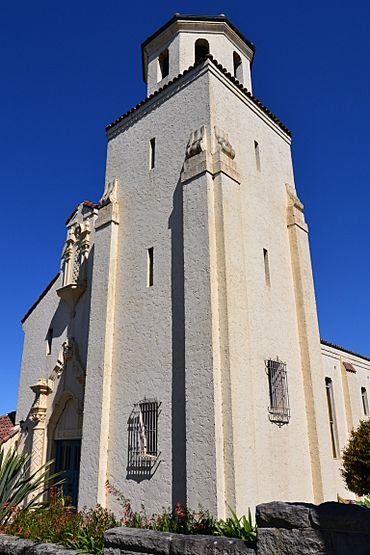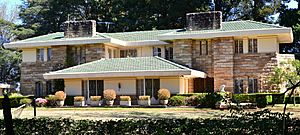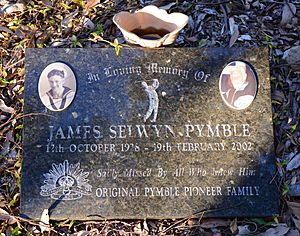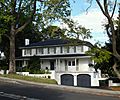Pymble, New South Wales facts for kids
Quick facts for kids PymbleSydney, New South Wales |
|||||||||||||||
|---|---|---|---|---|---|---|---|---|---|---|---|---|---|---|---|

Ku-ring-gai Town Hall, formerly the Sacred Heart Catholic Church.
|
|||||||||||||||
| Population | 11,775 (2021 census) | ||||||||||||||
| • Density | 1,808.8/km2 (4,685/sq mi) | ||||||||||||||
| Established | 1823 | ||||||||||||||
| Postcode(s) | 2073 | ||||||||||||||
| Elevation | 139 m (456 ft) | ||||||||||||||
| Area | 6.51 km2 (2.5 sq mi) | ||||||||||||||
| Location | 15 km (9 mi) north-west of Sydney CBD | ||||||||||||||
| LGA(s) | Ku-ring-gai Council | ||||||||||||||
| State electorate(s) | Davidson | ||||||||||||||
| Federal Division(s) | Bradfield | ||||||||||||||
|
|||||||||||||||
Pymble is a suburb in Sydney, New South Wales, Australia. It is about 15 kilometers (9 miles) north of Sydney's city center. Pymble is part of the Ku-ring-gai Council area.
West Pymble is a different suburb located nearby, next to the Lane Cove National Park. Pymble is known for its beautiful gardens, natural bush areas, and old, important buildings.
Contents
Pymble's Past: A Look at History
The land that is now Pymble was once home to the Cammeraigal clan of the Kuringai Aboriginal people. They traveled through this area, from Cowan Creek to the Parramatta River. They would hold special gatherings called corroborees at the site of the Pymble Reservoir today.
Pymble gets its name from Robert Pymble (1776–1861). He was an important early settler who received a large land grant in 1823. This grant covered about half of the Pymble area. Another settler, Daniel der Matthew's, owned the other half and built the first sawmill here.
How Pymble Grew: From Timber to Homes
In the early days of the Sydney colony, Pymble was very important for its timber. Trees like blackbutt, stringybark, iron bark, and blue gum were cut down for building. Later, the area became known for its farms, especially for growing oranges. Robert Pymble brought oranges to the area around 1828.
Over time, farming gave way to homes. People started buying land to build houses around 1879. The first bank, the Australian Joint Stock Bank, opened in 1888. It was in a house called Grandview on Pymble Hill. The Gardener's Arms Hotel had opened there earlier, in 1866.
At first, the main shops and businesses were at the top of Pymble Hill, near the Pacific Highway. But when the railway station was built at the bottom of the hill, things started to change. More development moved towards the station. The Pymble Post Office opened there on August 6, 1890.
Today, Pymble is mostly a residential area with many homes and gardens. It has lots of parks and natural reserves. You can still find shops and businesses, especially near Pymble Station and along the Pacific Highway. Pymble also has many beautiful Federation-style houses, showing its rich architectural history.
Important Old Buildings in Pymble
Pymble has several places that are listed as heritage sites, meaning they are important to history. These include:
- Pacific Highway: Pymble Reservoirs No. 1 and No. 2
- 982–984 Pacific Highway: Pymble Substation
- 29 Telegraph Road: Eric Pratten House
Cool Buildings to See

- Ku-ring-gai Town Hall: This building is at the top of Pymble Hill. It used to be the Sacred Heart Catholic Church, built in 1934. It has a unique Spanish Mission style.
- Pymble Chapel: Located on the corner of Mona Vale Road and Bromley Avenue, this chapel was built in 1879. It was the second church in Pymble and is the oldest building still standing in the suburb.
- St Swithun's Anglican Church: On Telegraph Road, this church was built around 1938. It has a Gothic style and is the only church in Australia named after St Swithun.
Historic Homes to Discover
- Grandview: This two-story sandstone building was built around 1870. It was first a bank but is now a home.
- Merrivale: This grand home is in the Regency style. It is considered one of the best examples of its kind in Ku-ring-gai.
- Coppins (Eric Pratten House): Designed by the famous architect Walter Burley Griffin around 1936. It's special because most of his houses were single-story, but this one is larger. It shows an Art Deco/Prairie style.
- Macquarie Cottage: On Avon Road, this cottage was designed by William Hardy Wilson in 1918. It's a great example of his work.
- Sacred Heart Presbytery: This two-story house was built in 1907. It has a Federation Arts and Crafts style with some Gothic details.
- Colinroobie: A large two-story Federation mansion built in the early 1900s. You can find it at the corner of the Pacific Highway and Clydesdale Place.
Getting Around Pymble: Transport Options
Pymble railway station is on the North Shore railway line, making it easy to travel by train.
The Pacific Highway runs through Pymble. Also, the intersection of Mona Vale Road and Ryde Road marks the southern edge of the suburb.
Buses also serve Pymble. Route 579 goes from Pymble station to East Turramurra during busy times. Route 560 travels from Gordon station to West Pymble. Route 575 runs along the Pacific Highway, going south to Macquarie University and north to Turramurra station and Hornsby station.
There is also a taxi stand near the station on Grandview Street.
Shopping and Business Areas
Pymble has several places where you can shop and find businesses:
- Pymble Shopping Village on Grandview Street, right next to the railway station.
- Areas along the Pacific Highway near Pymble station.
- Bridge Street and West Street.
Schools in Pymble
Pymble is home to several schools for different age groups:
- Pymble Ladies' College (Kindergarten to Year 12)
- Pymble Public School, a government primary school on Crown Road. Famous alumni include actors Hugh Jackman and Chris Lilley.
- Sacred Heart Catholic Primary School (Kindergarten to Year 6)
- Gordon West Public School (Kindergarten to Year 6), located in West Pymble.
Parks and Fun Places
- Robert Pymble Park: This park is next to the railway line. It has big trees, tennis courts, a playground, and facilities.
- Bannockburn Oval: A large sports field on Bannockburn Road. It's used for athletics, cricket, soccer, rugby, and other sports.
- The Pymble Soldiers Memorial: On Mona Vale Road, this park honors those who served in wars. It has beautiful rose beds and offers a view from the hilltop.
- Dalrymple-Hay Nature Reserve: Located on Mona Vale Road, this is one of the last remaining blue gum high forests in Sydney. You can walk among tall blue gums and blackbutts and see native birds like king parrots and rosellas.
- Sheldon Forest: This bush reserve has walking paths accessible from Warragal Road. The track goes through different types of forests, including rare ones like Sydney Turpentine Ironbark Forest and Blue Gum High Forest.
- West Pymble Scout Group: Offers Scouting activities for young people aged 8-15 at West Pymble Bicentennial Park.
- Rover Scout Crews: Groups like Turramurra, Kissing Point, and Gordon Rover Scout Crews are for young people aged 18-25. They enjoy outdoor activities, social events, and community service.
Pymble's People: Demographics
In 2021, Pymble had a population of 11,775 people.
- The average age was 41 years old.
- About 53.1% of people were born in Australia. Other common birthplaces included China (12.2%), England (4.5%), and Hong Kong (3.3%).
- About 60.4% of people spoke only English at home. Other languages spoken included Mandarin (15.5%) and Cantonese (5.8%).
- Most homes (72.4%) were separate houses. About 24.8% were flats or apartments.
Famous People from Pymble
Past Residents
- Belinda Bauer, actress and psychologist
- Errol Flynn, actor
- Hugh Jackman, actor
- Stirling Mortlock, rugby union player and former Australian Wallabies captain
- John Symond, businessman
Current Residents
- Liane Moriarty, author
- John Newcombe, tennis player
- Todd McKenny, dancer
Images for kids











